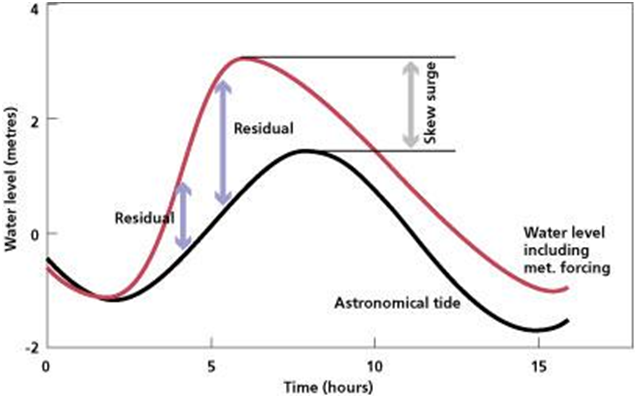A skew surge is the difference between the maximum observed sea level and the maximum predicted tide regardless of their timing during the tidal cycle – there is one skew surge value per tidal cycle. The maximum observed sea level measured by tide gauges are primarily determined by the tidal regime. The difference (residual) between the maximum observed sea level and the maximum predicted tide is governed by the wind stress and the local atmospheric pressure, roughly a two thirds to one third split respectively.

The skew surge statistics for the UK used data from all of the tide gauges within the United Kingdom’s National Tide Gauge Network. The data used for compiling the individual site histories were from the period from the beginning of each tide gauge record up to 1 January 2013. The tide gauges are in strategic positions around the coast, which help to monitor, and hence protect key infrastructures from, extreme sea levels. For example, since 1990 there has been a tide gauge at Hinkley Point in Somerset, which is an integral part of the nuclear power station site. Heysham nuclear power station also has a tide gauge located nearby for the same purpose. Major naval and industrial ports are monitored by tide gauges, for example, Aberdeen and Dover, which have 82 and 89 years of tide gauge data respectively.
The data were quality checked by the British Oceanographic Data Centre; we removed data flagged as having improbable values (M) and null values (N), however, we kept in our data set those flagged as interpolated from adjacent values (T).
The average time span of a UK tide gauge time series is 36 years. Newlyn has the longest tide gauge record spanning 98 years. The average percentage of complete data from all the tide gauges was 87%.
There are great variations in tidal regime around the UK coastline. Avonmouth experiences the second highest tides in the world with mean high water springs recorded at 13.33m. While the lowest tidal amplitude occurs at Port Ellen where the mean high water springs value is 0.78m. The purpose of this compilation was to ascertain whether there was a correlation between the skew surge and the predicted maximum tide, and whether there was a correlation between the skew surge and the maximum sea level observed by the tide gauge.
The results are displayed by region: England – South, England – East, England – West, Wales, Scotland, Northern Ireland, Isle of Man, Channel Islands